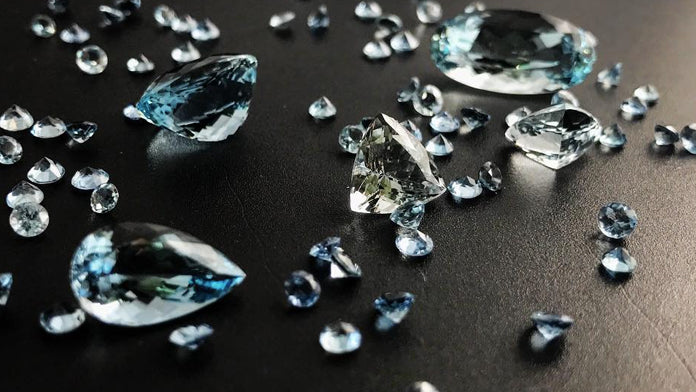
There are gems that are desired for their value and there are gems that are desired for their absolutely unique color: among these is Aquamarine . This splendid precious stone has seen its popularity grow in the jewelery market due to its blue color and strong symbolic meaning: Aquamarine means "Sea water" in Latin, and like the sea it represents euphoria and relaxing calm ; encourages letting go of feelings, purifying the mind of negative thoughts.
AQUAMARINE: THE HIDDEN MEANING BEHIND ITS BEAUTY
Many legends tell stories inspired by the properties of this gem which concern water and oceans. Both the Greeks and the Romans adored it and called it the " sailor's gem ": if overwhelmed by a storm, sailors threw aquamarine gems into the sea to appease the wrath of the gods, or wore them as amulets. In the Middle Ages it was believed that this stone, cut like a sphere, had divinatory properties : just as the sea becomes the mirror of the sky, so aquamarine, becoming a mirror, would allow the hidden meanings of reality to be discovered. It is, in fact, a blue crystal of great significance to prophets, shamans, healers and mystics. The calming effects of celestial stone are ideal for emotional, spiritual and physical healing.

AQUAMARINE: THE CHARACTERISTICS
Aquamarine, from which splendid rings, necklaces and precious bracelets are obtained, is a variant of the mineral Beryl and crystallizes with a hexagonal system into beautiful blue crystals. These crystals can be up to a meter long and totally transparent. Aquamarine stone is formed from volcanic rocks and is found within granite pegmatites, in groups of intertwined crystals; It has properties that are particularly appreciated also in the industrial sectors of aeronautics and nuclear energy due to its strength and low intensity.
The magnificent color depends on the presence of titanium and iron and ranges from blue-greenish to blue, from turquoise to blue, from clear to opaque: “Milky” aquamarines are milky due to the presence of regular inclusions.

MOST IMPORTANT DEPOSITS AND VARIETIES OF AQUAMARINE STONE
Before the discovery of African deposits , the most precious specimens were extracted around 1830 in the Brazilian areas of Minas Gerais and in the Ural Mountains . Brazil is still one of the world's largest exporters of this gem, although other countries such as Nigeria, Madagascar, Mozambique and Zambia have gained an important role in the extraction of Aquamarine.

The varieties of aquamarine are classified according to their extraction location: Santa Maria aquamarine is a rare aquamarine with an intense blue hue, coming from the Brazilian locality Santa Maria de Itabira; the Sao – Domingos aquamarine features a classic pastel blue, the Santa Teresa aquamarine features a brilliant turquoise blue. Boca-Rica aquamarine takes its name from the Brazilian deposit where gems with exotic shades reminiscent of sea foam are extracted. Pedra Azul is famous for its deep dark blue, as is Maxixe aquamarine , mined in Madagascar.
AQUAMARINE JEWELRY: COST AND VALUE
The price of aquamarine depends on the size, the beauty of the color, the perfection of the cut . The most common cuts are oval and rectangular: thanks to its characteristics and cut, aquamarine reflects a lot of light. The intense blue color is considered more valuable than a pale blue aquamarine. Generally, larger aquamarines (over 5 ct) show a more vivid blue, which increases their value.

Among the most famous aquamarine jewels, we remember the necklace with aquamarine earrings that the president of Brazil gave to Elizabeth II for her coronation in 1953, in the name of the Brazilian people. But the most famous aquamarine jewel that represents Rebirth and Revenge is the "Asprey Ring": the ring with aquamarine and diamonds that Princess Diana of England purchased after her divorce from her husband Charles, to replace the ring of engagement, for its calming and soothing properties.
In-depth analysis by Sonia Basso












